Hacker Perspective: Martial Arts • Karate Do • Health
Sensei Denis Robitailles assigned me the task of setting up this general web page as part of my Black Belt preparatory work (think of it as a poor-man's doctoral thesis in an effort to popularize karate training as an alternative form of physical-mental exercise). He verbally passed on much of this knowledge to me (this was the ancient tradition while martial arts training was outlawed in Okinawa). Other information came from Wikipedia,
What is a martial art? In Roman mythology, Mars was the god of war so any fighting art (or war art) was known to European culture as a martial art (or "art of Mars" or "Mars art").
To be very general, most European-sourced fighting styles tend to be closed-handed (fist) while many Asian-sourced fighting styles tend to be open-handed or mixed.
Menu:
- My Karate Training (Goju Ryu Karate and Kobudo)
- My Black Belt Grading (with graduation photo)
- life after COVID-19
Asian Martial Arts (10,000 foot view)
There are many Martial Arts but this web page follows one thread of Asian martial arts as it flowed from India, to China, to Okinawa, to Japan, to America, then finally to Canada.
| Who | B | D | Text |
|---|---|---|---|
| Bodhidharma | 482 | 539 | This Zen Buddhist Monk brought Buddhism, and martial arts, from India to China
|
| Higaonna Kanryo | 1853 | 1916 | Brings Okinawan Te to China then merged his knowledge with Chinese Kung fu to become Okinawan Karate |
| Funakoshi Gichin | 1868 | 1957 | Brings Okinawan Te to Japan then develops it into Shotokan Karate |
| Miyagi Chojun | 1888 | 1953 | Develops Okinawan Karate into Okinawan Goju-Ryu Karate
|
| Gogen Yamaguchi | 1909 | 1989 | continues to develop Japanese Goju-ryu Karate |
| Richard Kim | 1917 | 2001 | Born in the Territory of Hawaii before it became a US state, Kim learned judo and some Karate as a child. After World War 2 he lived for seven years in Japan teaching Okinawan Kobudo and Shōrinji-ryū. He introduced one of his students, Peter Urban, to Masutatsu Oyama and Gogen Yamaguchi |
| Peter Urban | 1934 | 2004 | Served with the American occupation forces in Japan during the decade following World War 2 Brings Goju-ryu from Japan to America then develops American Goju which morphs into GoJu USA |
Canadian GoJu
caveat: Eastern Asian names are almost always presented "surname first"
-
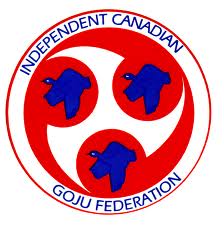 Okinawan Goju-Ryu
is started by Miyagi Chojun (yep, same surname of the janitor in the 1984 movie "The Karate Kid") in 1933.
Click here to read how Chinese Kung fu and three different
styles of Okinawan Te (Naha-te , Shuri-te , Tomari-te ) merged to become Okinawan Goju-Ryu
Okinawan Goju-Ryu
is started by Miyagi Chojun (yep, same surname of the janitor in the 1984 movie "The Karate Kid") in 1933.
Click here to read how Chinese Kung fu and three different
styles of Okinawan Te (Naha-te , Shuri-te , Tomari-te ) merged to become Okinawan Goju-Ryu
- Funakoshi Gichin introduces Okinawan Karate to Japan in 1922 where it is formalized then developed.
- Peter Urban (who trained in Japan under Sensei Richard
Kim and Gogen Yamaguchi in the 1950s) is not successful in obtaining permission from Yamaguchi to
start American Goju-Ryu but does so anyway.
- Sensei Marlene & Jerry Kasper
- create Independent Canadian GoJu Federation (ICGF) in 1994 after receiving permission from Peter Urban
- create Independent Canadian GoJu Federation (ICGF) in 1994 after receiving permission from Peter Urban
- Sensei Denis Robitailles
- this student of Marlene & Jerry Kasper receives permission from his former Sensei to continue Independent Canadian GoJu Federation
- http://www.robitaillesacademyofmartialarts.com/ICGF.html
Karate Do (Empty Handed Way : Way of the Empty Hand)
-
 Karate @ Wikipedia
Karate @ Wikipedia
Overview
- Karate begins in Okinawa as Tode-jutsu or Tode or To-te ("Te" means "hand")
- Te practitioners journeyed to China (Fuchow was an Okinawan settlement in those days) to learn various Chinese martial arts including Kempo, Kung Fu, Wushu, etc.
- The merged styles were brought back to Okinawa which later migrated to Japan where they are formalized and standardized.
- Karate definitions:
- Okinawan meaning of Karate: Way of the Chinese Hand (唐手)
- Japanese meaning of Karate: Way of the Empty Hand (空手)
History
- Okinawa is the name of the largest island in the chain of Ryukyu islands running between Japan and
Taiwan. Although the people of Okinawa were genetically and culturally linked to the people of Japan, Okinawa was considered a tribute state of China.
- see: Ryukyu Kingdom
- www.okinawakarate.com/enmapsite/federation/5period/period.html
- By 1372 trading relations between Okinawa and China had already existed for several hundred years. That year something which would have an enormous impact on not only the development of Okinawa Te but also on the history of Okinawa itself happened. The Emperor of Okinawa Satto voluntarily agreed to become a vassal of China. Under Chinese laws of that time, goods produced in countries belonging to China's protectorate were not liable to customs taxes. China was obliged to, in case of war, defend countries under its protectorate. A delegation of Okinawans signed the agreement in Peking with the Emperor Hang Wu Thai (Ming Dynasty).
- In 1393 an event called "Sanye Roku Sei" - "Thirty-six families" took place. A large group of Chinese settlers founded on Okinawa the village Kume Mupai not far from the city of Naha. The expression "Thirty-six" doesn't signify the number of settlers, but rather in the 15th century this Chinese character meant a large group of people. They had not come to wage war. Some of them were artists, craftsmen, and seafarers. They taught the Okinawans Chinese writing, education, and arts. Among them was also large group Tsuan Fa masters (Chinese Martial Art). Young people were more than happy to start learning a new type of martial art. It was right at this time that Tsuan Fa (Chinese Martial Art) and To De (Okinawan Martial Art) began to unite to create Ancient Okinawa Karate - a new martial art which had no equal. Okinawa was under Chinese protectorate for more than 200 years. Chinese Imperial Dynasties did not interfere in the internal affairs of Okinawa. This collaboration brought Okinawa a much higher level of education, economic improvement and increased trade. Okinawa sent its diplomats and high-ranking officials to study in China.
- By 1600 the Ming Dynasty was in decline. China was invaded by Mongolian hordes. The head of the South-Japanese clan Shimazu, Iehitsu Shimatsu decided to take advantage of this situation. With the emperor's permission and three thousand Samurais armed with muskets on 100 warships, seized Okinawa. The Okinawan Emperor was disposed. A small group of people loyal to the Emperor openly resisted the Satsuma. They were captured and sentenced to death. Several enormous cauldrons water were placed on a bonfires and they were thrown into the boiling water alive. Okinawans who witnessed the execution created a symbol - three twisted drops in a circle which reminded them of the boiling water in the caldron boiling when a man was thrown in. "Hidari Gomon" became the symbol of the fight of Okinawan inhabitants against Japanese Samurais and subsequently the symbol of Okinawa Te. It was the end of Okinawa's independence and the beginning of a harsh subjugation of the Ryukyu archipelago. (For more details click to "History/Japanese occupation".)
- The first official act of the Japanese in Okinawa was to disarm the population, shut down the Okinawa militia, and disband the Okinawa police.
- At that time, a Japanese soldier could arrest or kill an Okinawan citizen for no reason at all. To make matters worse, some superstitious shoguns believed that a
sword was not ready for combat until it had taken a life (usually done by taking the life of a criminal provided one was available). Likewise, some superstitious
sword-makers thought their creations would gain additional hardness if heated to a red-hot temperature then run-through a living person (they had no formal
knowledge of the science of metallurgy including Quenching). In order to protect themselves from their
Japanese overlords, some Okinawans rediscovered hand-to-hand martial arts then taught theses skills to others at night (many exercised in their pajamas in case they
were discovered). Since teaching martial arts was illegal, all information was passed orally from master to student; nothing was ever written down
(this is one reason why there is so much variation seen in today's history of karate; perhaps the internet can remedy this). At that time, three Te styles were
developed in the three major cities of Okinawa:
Okinawan City Style Naha Naha-te Shuri Shuri-te Tomari Tomari-te - Since they had no weapons they developed fighting styles based upon farming implements. Here is a very short list:
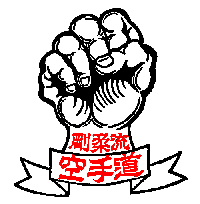
Goju Ryu
- In 1742, Shuri-te practitioner Sakukawa Kanga (1733-1815) journeyed to China to learn Kempo. He brought this knowledge back to Okinawa in 1762.
- In 1865, Naha-te practitioner Higaonna Kanryo (1851-1915) visited China to learn Kung Fu. He brought this knowledge back to Okinawa in 1878.
- Chojun Miyagi (1888-1953) merges Naha-te with Kung Fu and names the new style Goju Ryu ("Hard-Soft School" or "50 School")
- In 1922, Okinawan teacher Funakoshi Gichin (1868-1957) introduced Okinawan Karate to Japan. This morphed into a Japanese Karate style known as Shotokan
- Gogen Yamaguchi (1909-1989) was asked by Chojun Miyagi to popularize Karate in Japan
Related Articles
- Okinawan Martial Arts
- Japanese Martial Arts
- Korean Martial Arts
- Chinese Martial Arts
- Indian Martial Arts
- Martial Arts
- Hard and soft (martial arts)
- Shorin-Ryu
- Wado Ryu
- Bodhidharma (482 AD - 539 AD) is the Zen Buddhist Monk who brought martial arts from India to China
Miscellaneous Information
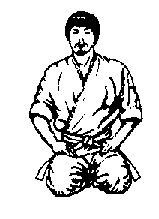 Dojo
Kun: a gift from Chogun Miyagi (B-T-P-B-T-L-D-C)
Dojo
Kun: a gift from Chogun Miyagi (B-T-P-B-T-L-D-C)
Hitotsu (each item has equal importance)
- Be humble an polite
- Train considering your physical strength
- Practice earnestly with creativity
- Be calm and swift
- Take care of your health
- Live a plain life
- Do not be too proud or modest
- Continue your training with patience
Six paths to better Kata (B-E-F-K-P-T)
- Breathing
- Eyes
- Focus
- Kiai
- Pace
- Technique
Karate Belt Colors
- kyu 6 white
- kyu 5 yellow
- kyu 4 orange
- kyu 3 green
- kyu 2 blue
- kyu 1 brown
- dan * black
Art Imitates Life
Learn more ways to preserve rather than destroy;
Avoid rather than check;
Check rather than hurt;
Hurt rather than maim;
Maim rather then kill;
All life is precious nor can it be replaced.
-- Master Khan to Grasshopper
| Grasshopper: | Master, I am troubled; We learn to make powerful our bodies yet we are taught to reverence all against whom we may use such force. |
| Master Khan: | When your life is threatened, or the innocent life of another, you will be prepared to defend them. |
| Grasshopper: | Being thus prepared better than others, should I not always stand and fight? |
| Master Khan: | Ignore the insulting tongue; duck the provoking blow; run from the assault of the straw. |
| Grasshopper: | Are these not the actions of a coward? |
| Master Khan: | The wild boar runs from the tiger knowing that each being well armed by nature with deadly strength, may kill the other. Running, he saves his own life and that of the tiger. This is not cowardice, this is the love of life. |
My Karate Training (Integrated with Weight Training)
- I work out every day for a minimum of 60 minutes (you brush your teeth everyday so why wouldn't you exercise everyday?)
Gymnasium
- do not work the same muscles every day; they need at least one day off (perhaps this is the day you go to the Karate Dojo)
- pick up enough weight to lift three sets of ten repetitions to the point of exhaustion (of that body part)
- do first set of 10 repetitions
- pause 30-60 seconds to allow your muscles to recover
- do second set of 10 repetitions
- pause 30-60 seconds
- do third set of 10 repetitions
- move on to a different body part
- future progress: Always try to increase your repetitions.
- eventually you will be able to do three sets of eleven but keep going
- once you are comfortable doing three sets of twelve, slightly increase the weight then return to three sets of ten repeating the whole cycle
- don't worry if you are unable to increase your reps. You are trying to get healthy so don't hurt yourself.
Junior Belts
- White
- everyone begins here
- performing kata is similar to a concert pianist doing scales on the keyboard
- Yellow
- Orange
Notes:
- I joined a Karate club after working out in a gym for 17 years and was able to keep up to people half my age so doing both can be beneficial (although this is optional)
- I attended Karate Class three times a week and was at the gym the other four
Senior Belts
- Green
- Blue
- Brown
- Black
Notes:

- Our Karate club, like most, do not break boards or punch concrete blocks.
- In our club, senior belts must also learn Tai Chi (108-step Yang style)
- In our club, senior belts must attend optional third-party seminars. I still recall several weekend self defense seminars with Toronto Police Sergeant Tom Sharkey and his crew.
- In our club, senior belt students at least 18 years of age must also study Kobudo which consists of
fighting with the use of Okinawan farming tools:
- bow, jo, sai, tonfa, nunchaku, Japanese Samurai Sword (via wooden bokken))
- and Philipino Eskrima Sticks.
- By the time I made it to Blue Belt I discovered I was becoming winded when sparing (kumite) with students half my age. To compensate, I changed my gym workouts so I had no 30-60 second pause between sets. Instead, I immediately rotate to my next set (of arms, or legs, or something else, etc.) so that my respiratory and circulatory systems were always busy while individual muscles were recovering. (IIRC, this was suggested by by Sensi Denis)
My Black Belt (shodan) Karate-Kobudo Grading
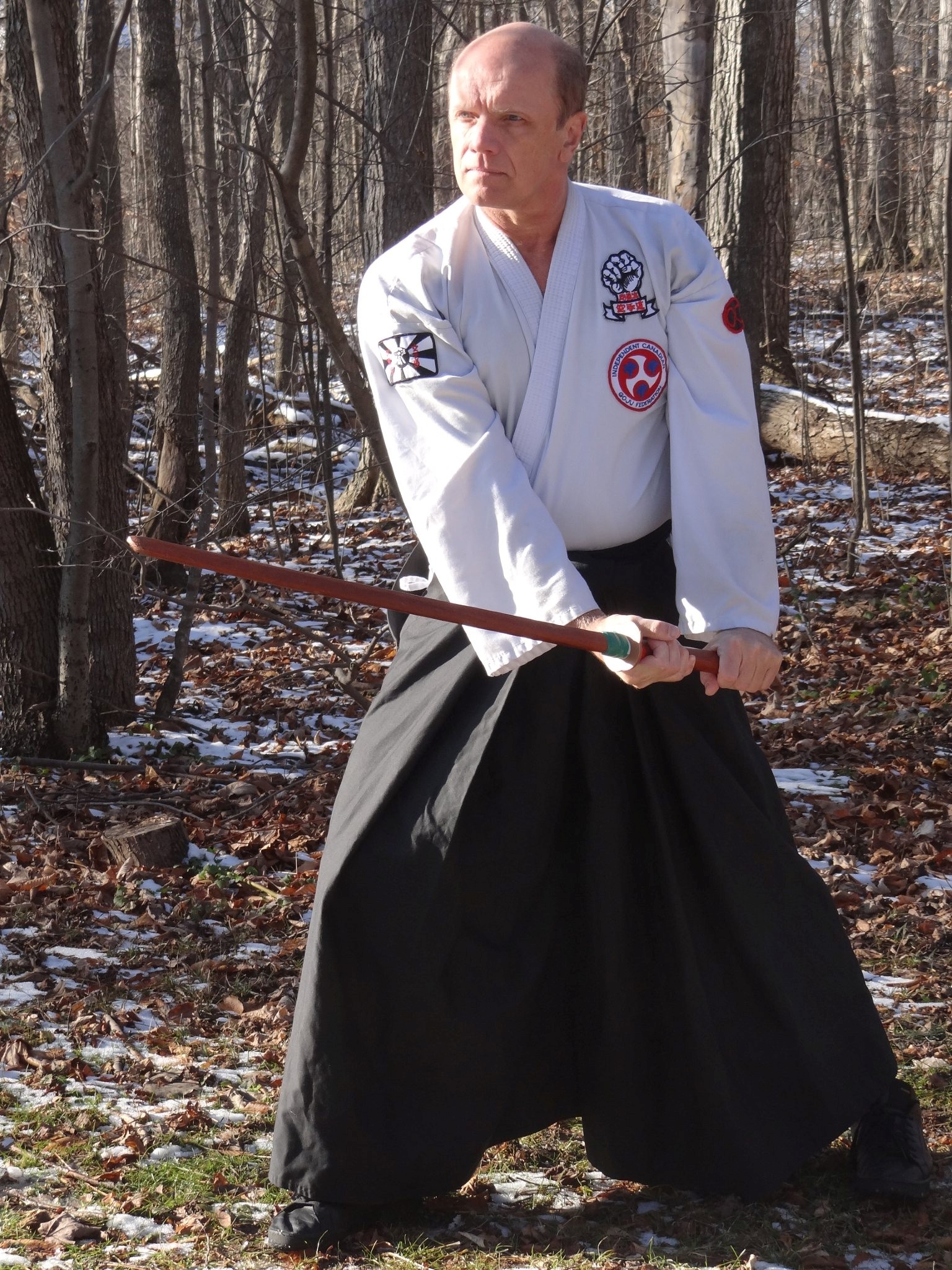
General
- Only brown belts were allowed to grade (there were two of us)
- Only black belts were permitted to attend (there were seven with Sensei and Sempai making nine)
- We were pre-warned there would be "no water breaks" and "no pee breaks" (also, could not bring a water bottle)
- We were pre-warned to expect the unexpected
- The whole grading was a few minutes shy of 6 hours with no rest of any kind
Details
- We did various Kata as requested by Sensei for the first two hours
- At the three hour mark, I was told to "rest up" by doing Tai chi (108-step Yang style) while the other student was asked to do Kobudo Kata. But this Tai chi came with a twist: this was the first time I ever did Tai chi while being periodically attacked with weapons (this grading did involve Kobudo). In fact, I was intermittently attacked by one of four armed black belts (one with a wooden dagger, one with Numchucks, one with a single Escrima stick, and one with a Tonfa). After each attack I was to continue my Taichi set at the point where I was interrupted. Yikes! No rest here!
- After 15 minutes of Tai chi it was my turn for Kobudo Kata and this went back and forth until the third hour was up.
- At the four hour mark
- we both participated in self defense where we were attacked (starting with our eyes closed) by fresh black belts and expected to defend and/or escape
- we also had to demonstrate 12 jujitsu self-defense techniques (I had only learned these 6-8 weeks before this grading)
- At the five hour mark
- we two students were asked to fight each other (full contact) and this went on for 6-7 minutes with my younger (18-year-old) opponent not holding anything back (didn't he know there was more to come?)
- At this point my opponent was asked to do Tai chi while I fought (full contact) a fresh black belt
- After a minute (which seemed much longer) my Sensei sent in a second black belt so now it was "two on one"
- After another minute he sent in a third so it was now "three on one" (at this point I was trying stuff like "yanking smaller guys between me and bigger guys" just so I could recover a bit)
- This went on until it was "six on one". After about a minute of this, I went down with a kick to the chest which I saw coming but was unable to block (my arms felt like they weighed a ton).
- Apparently my Sensei would have sent in more opponents until I did go down because the whole point of this was "not to win" but "to see how well the student handles a no-win situation" (reminds me of Star Fleet's Kobayashi Maru scenario). This was more instructive than anyone could know because "six people trying to attack you will get in each other's way" which leaves many openings for the defender if you haven't already lost the fight in your brain. Our club mascot is the dragon who's motto is "never give up" so now I pass this wisdom on to everyone reading this. You can survive 6-on-1 in real life but may need to draw blood (not allowed in a Karate club or Karate grading)
- Then I was asked to do Tai chi while the other student was put through the same wringer
- At the 5.5 hour mark there was a series of verbal tests involving Karate history etc.
- We finished a few minutes before the 6 hour mark
- This was the most physically demanding thing I have done as an adult
- The drive home was unusually quiet with a constant light snow fall (reminded me of Kill Bill vol2).
- When I arrived home my wife wouldn't let me through the door because my Karate gi was covered with CSI-like blood splatters but none of it was mine (I have no idea where it came from; drawing blood will prematurely end a grading)
- Measuring my weight revealed that I had lost 5 Kg (11 pounds) due to water loss. My legs started to cramp up so I quickly downed three one-liter bottles of Perrier
- An hour later I went for a stroll around the neighborhood but walked like an old man (so much for the great Karate student)
- The next day my body ached like I had been in a car accident
- I was physically unable to go to the gym for the next three days
Lessons Learned (my advice to you)
- I trained 5-months for this grading and added 10-pounds to my body weight (went from 210 to 220)
- this was a mistake and I now know that I should have lost 10-pounds because I might have been the heaviest person there.
- I carried that extra weight for 6 hours.
- I was carrying that extra weight when sparing (six-on-one) with younger, lighter opponents.
- I knew the grading would be 5-6 hours but never worked out more than 90 minutes.
- I should have spent some gym time doing light-to-medium exercises for 5-6 hours "just to feel what 6-hours was like".
- I recommend you do this once every two weeks for 3-4 months before your grading
- Do not do this 10-days prior to your grading; you do not want to over-train
- I should have spent some gym time doing light-to-medium exercises for 5-6 hours "just to feel what 6-hours was like".
Going Forward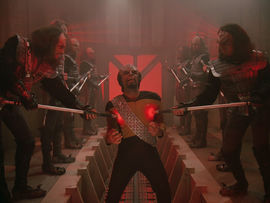
- Because my black belt grading lasted just a few minutes short of 6-hours, I attempt to do a 6-hour workout at the gym every year on the anniversary. I do not do
anything extraordinary but I do a combination of the following without stopping:
- jog on a tread mill for one minute followed by running for a minute (this example of interval training lasts 20-mnutes)
- lift weights (just half of my maximum amount)
- 10-minutes on a cross-trainer
The Icarus Factor is the title of a Star Trek TNG episode which ends with Warf enduring the Klingon Second Rite of Ascension Ceremony (video) which involves torture by one's peers. I think about my Shodan Grading every time I watch that episode. Why? I did not think I was ready to do this grading but my Sensei thought otherwise. I had five months to prepare and yet at least once every week I thought about walking away from Karate. But, like Warf, I suspected I might be a better person for passing though this trial by fire. I'm glad I did.
Plug for "My Karate Dojo" in Kitchener - Waterloo
 Robitaille's
Academy of Martial Arts (RAMA)
Robitaille's
Academy of Martial Arts (RAMA) 329 King St. E.,
Kitchener, Ontario, Canada. N2G-2L2
Telephone: 519-743-4800
e-mail: robitaillesmartialarts@bellnet.ca
web1: http://www.robitaillesacademyofmartialarts.com/ (now offline - this dojo did not survive COVID-19)
web2: https://www.facebook.com/pages/Robitailles-Academy-of-Martial-Arts/127501723955636
web3: https://www.facebook.com/denis.robitaille.1485

Goju Ryu
- Goju-Ryu Karate (accredited through the Independent Canadian GoJu Federation)
- Ju-jitsu (accredited through the World Ju-Jitsu Federation)
- Traditional Yang-style Tai Chi
- Traditional Kobudo (weaponry)
Life after COVID-19 ???
COVID-19 permanently ended life at the RAMA dojo ( dōjō ) in Kitchener but I was able to reserve one-hour work outs at the LA Fitness gym. The province of Ontario reduced the total number of gym patrons to 20 per hour in December-2021. This was reduced to 10 per hour for the first two weeks of January until a Province-wide lock-down closed the gym.
The gym reopened on February-16 and I was the only person there in the 10 AM slot (are people suffering COVID-19 fatigue or just a bad snow day?). Anyway, there are a lot of large oval signs on the wall of the gym and one of them says:
...which is pretty hard to do when all those pro-politics anti-science idiots are claiming that COVID-19 deaths are not real, etc. So you have to put all that aside and "Respect Yourself" by making an effort to exercise, eat properly, and get a decent amount of sleep. The "Respect Yourself" sign also got me thinking about dojo kun (click the link to see what that is all about
 Back to Home
Back to Home
Neil Rieck
Waterloo, Ontario, Canada.